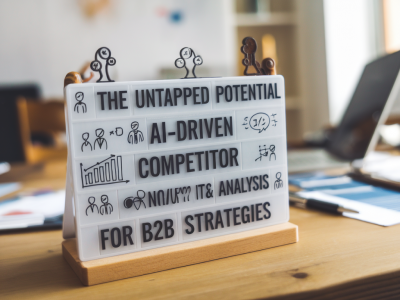
When it comes to enterprise collaboration tools, most companies look for solutions that help streamline communication, enhance productivity, and foster innovation. In a rapidly changing digital landscape, the ability to collaborate effectively across teams, departments, and even continents has become a cornerstone of modern business success. Recently, Adobe’s B2B suite has been generating buzz for redefining what collaboration looks like in the enterprise space. Today, I’m excited to dive into this development and discuss why Adobe’s suite is setting a new standard for enterprise tools.
Understanding Adobe’s B2B Suite
Adobe, a company synonymous with creativity and design, has long been a leader in software solutions for industries ranging from marketing to media production. However, the latest evolution of their B2B offerings expands into something far more comprehensive. Adobe has invested heavily in creating a suite of tools designed not just for individual creators, but for entire organizations, aiming to bridge the gap between creativity, collaboration, and business operations.
At its core, Adobe’s B2B suite builds upon its digital experience platform (DXP) by integrating tools like Adobe Creative Cloud, Adobe Experience Cloud, and Adobe Document Cloud. Each of these elements is thoughtfully designed to tackle key pain points for enterprises, such as cross-functional collaboration, data-driven decision-making, and document management at scale. But what truly sets Adobe apart is how well these tools integrate within the context of an enterprise ecosystem, enabling real-time collaboration and innovation across teams.
Why Collaboration Matters More Than Ever
Collaboration is no longer a choice for organizations—it’s an imperative. Whether you're running a multi-national corporation or a fast-growing startup, the need for seamless collaboration tools has never been greater. Hybrid work environments, global teams, and the increasing complexity of projects all demand software that is flexible, intuitive, and powerful enough to keep workflows streamlined.
That’s where Adobe’s B2B suite shines. Unlike traditional productivity tools that simply allow users to share files and send messages, Adobe's solutions encourage real interaction and co-creation. For example, Adobe Creative Cloud enables teams to work together on design projects in real-time, regardless of their geographical locations. These collaborative features are further enhanced by cloud-based storage and integrations with other business tools.
Key Features Redefining Enterprise Collaboration
So, what exactly makes Adobe's B2B suite a game-changer? Let’s explore some of its standout features:
- Real-Time Co-Creation: Tools like Adobe XD and Photoshop now allow team members to collaborate on the same project simultaneously. This is a huge win for enterprises where design, marketing, and product development teams often need to align in real-time.
- Seamless Integrations: Adobe’s suite integrates effortlessly with other popular enterprise tools, including Microsoft Teams, Slack, and Salesforce. This connectivity ensures that teams have everything they need in one place.
- Data-Driven Insights: Adobe Experience Cloud leverages AI and machine learning to provide actionable insights that drive smarter decision-making. From understanding customer behaviors to optimizing marketing campaigns, the possibilities are transformative.
- Efficiency in Document Management: Through Adobe Document Cloud, enterprises can manage, edit, and sign documents securely and efficiently. With electronic signatures gaining widespread adoption, this feature is no longer a nice-to-have but a must-have for any business.
Breaking Down Silos with Adobe
One of the biggest barriers to collaboration in traditional enterprises is the presence of silos—departments working independently without sharing valuable insights or working toward unified goals. Adobe’s approach effectively dismantles these silos by creating a unified environment where information, creativity, and data flow freely across teams.
For instance, Adobe Experience Cloud ensures that marketing teams can easily access customer data and use those insights to create highly personalized campaigns. Meanwhile, the integration with Adobe Creative Cloud allows these campaigns to be designed, reviewed, and approved without the back-and-forth email chains that often bog down timelines.
This level of integration not only improves efficiency but also fosters a culture of transparency and collaboration, empowering teams to deliver better results faster.
How Adobe’s Tools Differ from Competitors
You might wonder how Adobe’s B2B suite stacks up against popular collaboration tools like Microsoft 365 or Google Workspace. While these platforms have their strengths, Adobe takes a unique approach by focusing heavily on creativity and customer experience management in addition to productivity and collaboration.
For instance, while Microsoft Teams is great for communication and file sharing, it doesn’t offer the same level of advanced design tools as Adobe’s Creative Cloud. Similarly, while Google Workspace excels at cloud-native document editing, it lacks the data-driven capabilities and integrations offered by Adobe Experience Cloud. This combination of creative and analytical tools is where Adobe truly shines, making it a preferred choice for enterprises seeking a comprehensive solution.
The Role of AI and Automation
Another standout feature of Adobe’s B2B suite is the company’s focus on AI and automation. Adobe Sensei, the AI engine that powers many of their tools, enables features that were unimaginable just a few years ago. From automating repetitive tasks in Photoshop to predicting customer behaviors in Experience Cloud, Adobe Sensei helps teams save time and focus on high-value, creative work.
AI-powered automation is particularly powerful for enterprises. Whether it’s auto-generating marketing content based on performance data or enhancing images and videos at scale, these capabilities eliminate bottlenecks and allow for faster innovation.
What Does This Mean for Your Business?
As someone who is closely following the evolution of business technology, I’ve often noticed that the tools you choose can directly impact your team’s productivity, creativity, and overall performance. Adobe’s B2B suite isn’t just another set of tools; it’s a comprehensive ecosystem designed to transform the way enterprises operate.
By fostering real-time collaboration, breaking down departmental silos, and leveraging cutting-edge AI and automation, Adobe is enabling organizations to unlock new levels of efficiency and creativity. Whether you’re a marketing agency, a product development team, or a multinational corporation, these tools offer tremendous potential to streamline your workflows and drive better outcomes.
If you’re curious about how Adobe’s suite might fit into your business landscape, I encourage you to explore their offerings with an eye toward integration and scalability. After all, in today’s fast-paced B2B world, staying ahead often comes down to choosing the right tools to support your team’s ambitions.

